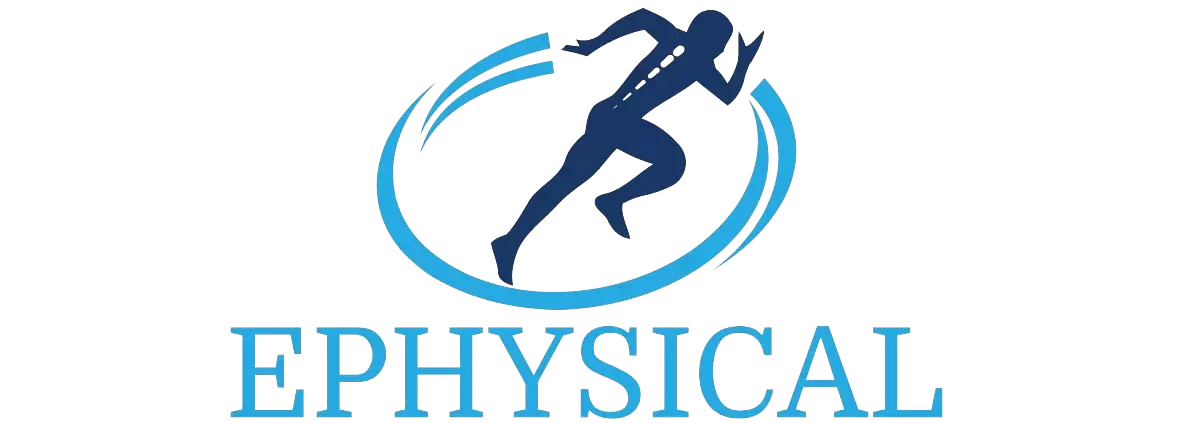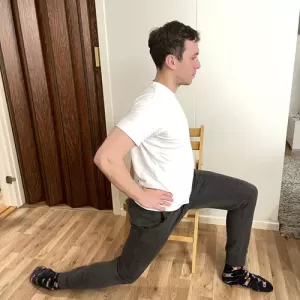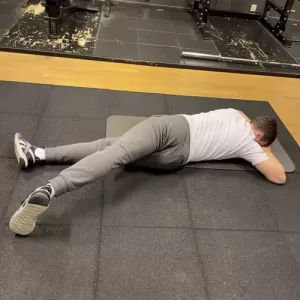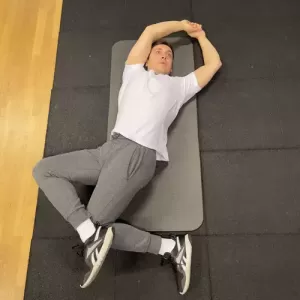Sartorius Stretch: The Complete Guide for Stretching Your Sartorius Muscle
In this article, I will dive into the world of sartorius stretching and provide you with a comprehensive guide to stretching this important muscle.
You will also learn:
- Understanding the function of sartorius muscle
- Symptoms of tight sartorius
- effective stretching exercises and foam rolling techniques
- Common questions about the sartorius muscle answered by a physiotherapist
Whether you’re a seasoned athlete or just looking to improve your overall muscle health, learning how to perform sartorius stretch will improve your body function and physical performance.
Sartorius Stretch: The most effective stretches for flexibility and pain relief
Seated Sartorius Stretch with a Chair
Start from sitting on the edge of a chair.
While sitting, extend one leg behind your body.
Rotate slowly your upper body towards the opposite side.
Hold this stretch for 30s.
Your hip should be slightly rotated inward.
You can improve this stretch by rotating your knee externally, but this is not recommended if you have any knee issue, such as meniscus tear.
Prone Sartorius Stretch
Lay down on your stomach and rotate one leg to the opposite side.
Try to touch the floor with your toes.
Your hip should be in extension and slightly adduction.
This position is favorable for stretching your sartorius muscle.
Keep this position for 30s.
Supine Sartorius Stretch
Lay down on your back. Cross your legs so that you can rotate one leg at the knee level.
Lift your arms up while rotating your knee into adduction and slightly hip extension.
Hold this position for 30s.
Understanding the Sartorius Muscle
The sartorius muscle originates from the spina iliaca anterior superior (SIAS) and inserts into the medial aspect of the tibia.
It runs down the front of the thigh, passing across the knee and attaching to the tibia.
The muscle is thin and elongated, allowing it to perform a variety of functions.
Sartorius is involved in the following movements:
- Hip flexion
- Knee flexion
- External rotation of the hip
The muscle also helps to stabilize the hip and knee during dynamic movements such as walking, running, and jumping.
Additionally, the sartorius muscle contributes to the overall posture of the body, helping to maintain proper alignment.
Tightness in sartorius is a contributing factor to anterior pelvic tilt, and it’s often seen in people who sit a lot or who engage in physical activities with repetitive knee and hip flexion.
Over time, this tightness can cause discomfort and decreased range of motion, making it important to incorporate sartorius stretch and foam rolling into your fitness routine.
Sartorius Foam Rolling
How to Foam Roll Your Sartorius
Foam rolling your sartorius muscle is a simple and effective way to improve hip and knee mobility and reduce muscle tightness.
To foam roll your sartorius, you will need a foam roller and a flat surface, such as a mat or carpet. Here is a step-by-step guide on how to foam roll your sartorius:
- Start by laying down on the floor with face looking downward.
- Place the foam roller under the front of your thigh, near your hip.
- Rotate with your body slightly, so that the sartorius muscle on the top leg is resting on the foam roller.
- Use your arms to slowly roll up and down the length of the sartorius muscle, from the hip to the knee.
- Repeat this process for 1-2 minutes on each leg.
Benefits of Foam Rolling Sartorius
Foam rolling the sartorius muscle offers a variety of benefits for both physical and athletic performance. Here are a few of the key benefits:
- Improved Mobility: Foam rolling sartorius muscle can help to increase flexibility and improve mobility in the hip and knee.
- Reduced Tightness: Regular foam rolling can help to reduce tightness in the sartorius muscle, which can contribute to improved posture and reduced pain or discomfort.
- Increased Circulation: Foam rolling promotes blood flow to the muscle, helping to deliver oxygen and nutrients to support healing and recovery.
- Improved Athletic Performance: By reducing tightness and improving mobility, foam rolling the sartorius muscle can help to improve athletic performance and reduce the risk of injury.
Foam rolling sartorius should be a regular part of a comprehensive recovery routine, along with sartorius muscle stretch.
By including foam rolling in your routine, you can help to keep your sartorius muscle healthy and functioning optimally and reduce the risk of injury and discomfort.
Most Common Questions About Sartorius
Why is Sartorius Called Honeymoon Muscle?
The sartorius muscle is sometimes referred to as the “honeymoon muscle” due to its long and thin shape, which is similar to the traditional pose of a bride in a wedding dress.
How Do You Know if Your Sartorius is Tight?
Reduced hip flexion combined with external hip rotation is a sign of sartorius tightness. If you have difficulties performing the sartorius stretch, you may have tightness in this muscle.
A physiotherapist can test the flexibility of sartorius manually.
What is the Antagonist to Sartorius?
Muscles that work against sartorius are knee extensors like m. quadriceps.
Is Sartorius the Strongest Muscle?
Nope, this muscle is not the strongest muscle in your body, but sartorius is the longest muscle in your body.
What are the Three Functions of the Sartorius?
Hip flexion, abduction (slightly), and knee flexion. With knee flexed, sartorius rotates your knee medially.
Do Squats Work Sartorius?
Yes, squats can help to strengthen the sartorius muscle. Squats are a compound exercise that engages multiple muscles in the legs and hips, including the sartorius.
Conclusion
In this article, you will learn the importance of stretching the sartorius muscle and all the benefits it brings to your body. I covered the anatomy of the sartorius muscle and its functions, as well as the common symptoms of tight sartorius. You will also learn how to foam roll sartorius to relieve muscle tension.
In the end, you will find the most frequently asked questions about the sartorius muscle, including its nickname, “honeymoon muscle,” and its role in various movements and postures.
I hope that this article has provided you with valuable information about the sartorius muscle and how to care for it.
Now it’s your turn to put this knowledge into action.
Start with sartorius stretching and foam rolling today, and share your experience with others.
Check out these articles about home stretching equipment and best books about stretching and flexibility.








